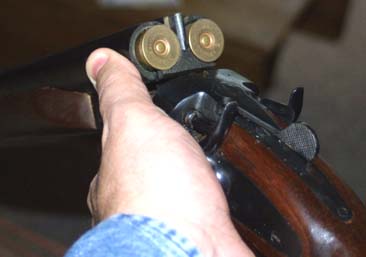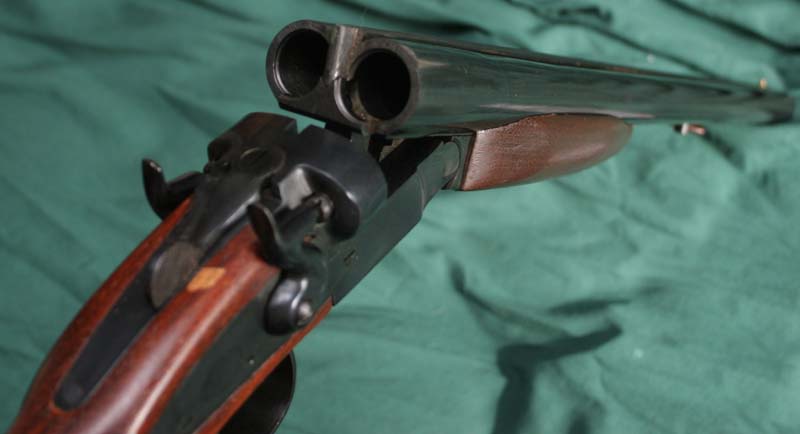|

Coach Gun
| Length Overall |
Barrel Length |
Weight |
Gauge |
Action Type |
Capacity |
| 36 Inches |
20" |
9 pounds |
12ga |
Double Barrel, ext hammer |
2 |
 A classic, double barreled shotgun, in the tradition of the
old west. This gun is equipped with external hammers, and double triggers.
It fires the 12 gauge cartridge, and has a simple and robust mechanism.
The gun is short, but the double barrels make it rather heavy. The external
hammers are handy, giving the option of having the chambers loaded,
without having to worry about an accidental discharge. There is no safety
on this type of weapon, and none is really required. There are three design
distinctions which categorize this piece as a "coach gun." The first, is
the presence of those external hammers and double triggers, descended from
the lock mechanisms of the old black powder rifles, and shotguns. Next is
layout of the barrels, side by side rather than over and under. Last, is
the shortness of the barrels, and the general compactness of the weapon as
a whole. Shotguns of this type were issued to stage coach guards, thus earning
them their names. A classic, double barreled shotgun, in the tradition of the
old west. This gun is equipped with external hammers, and double triggers.
It fires the 12 gauge cartridge, and has a simple and robust mechanism.
The gun is short, but the double barrels make it rather heavy. The external
hammers are handy, giving the option of having the chambers loaded,
without having to worry about an accidental discharge. There is no safety
on this type of weapon, and none is really required. There are three design
distinctions which categorize this piece as a "coach gun." The first, is
the presence of those external hammers and double triggers, descended from
the lock mechanisms of the old black powder rifles, and shotguns. Next is
layout of the barrels, side by side rather than over and under. Last, is
the shortness of the barrels, and the general compactness of the weapon as
a whole. Shotguns of this type were issued to stage coach guards, thus earning
them their names.
Around the time of the first world war, these types of
weapons began to fall into disfavor, among the general shooting public. The new pump, and semi auto guns offered lighter weight, and more firepower,
in a slightly longer package. A well made repeater could also be made to
cost less than a well made double. Though doubles were still being made,
they tended to be of rather low quality, in an attempt to stay cost competitive
with the repeaters. This was particularly true of the side by side shotguns.
Though some excellent double guns continued to be made, the cost of the
better quality models put them out of the reach of most shooters. Double
barrel enthusiasts who were not rich, had to settle for some less than ideal
guns. This is a consequence of the difficulty in aligning the twin barrels
to the same point of aim, and of the general expense of creating, essentially,
two guns set in one stock. Though repeaters have a more intricate mechanism,
they lend themselves much more readily to modern production methods, than
the venerable double gun.
The new pump, and semi auto guns offered lighter weight, and more firepower,
in a slightly longer package. A well made repeater could also be made to
cost less than a well made double. Though doubles were still being made,
they tended to be of rather low quality, in an attempt to stay cost competitive
with the repeaters. This was particularly true of the side by side shotguns.
Though some excellent double guns continued to be made, the cost of the
better quality models put them out of the reach of most shooters. Double
barrel enthusiasts who were not rich, had to settle for some less than ideal
guns. This is a consequence of the difficulty in aligning the twin barrels
to the same point of aim, and of the general expense of creating, essentially,
two guns set in one stock. Though repeaters have a more intricate mechanism,
they lend themselves much more readily to modern production methods, than
the venerable double gun.
There had always been a small following, for these types
of guns, among certain sports shooters. In addition to the rugged simplicity
of the piece, these weapons are easier to clean, and not at all fussy about
ammunition. A double gun cannot jam. A double is also capable of delivering
the fastest follow up shot of any type of firearm, since there is no action
to cycle. The largest following is among skeet, or trap shooters, for which
the rapid second shot, is a big factor. The weight of the twin barrels is
actually an advantage in this type of shooting. The classic coach gun, however,
is unsuited to this type of shooting, and most of those competing use the
over/under style of double. This gives a clear sight plane, centered over
both barrels. These guns also, generally, have a single, selective trigger,
and are hammerless.
 The coach gun has increased in popularity over the last
several years, because of an increase of interest in cowboy style shooting.
This is pretty similar to the resurgence of popularity that the old Colt SAA
experienced decades ago. These matches require authentic weapons, true to
the times. This includes single action pistols, lever action rifles, and double
barrel shotguns. The only other shotgun permitted at these events is the
old Winchester 97, the pump gun that cleaned the trenches during the first
world war. Though it is allowed, the old 97 is not greeted enthusiastically
by many purists. The cowboy shooting leagues have competitions all of the
country, and championships out west every year. Participants use authentic
weapons, and accessories, and even wear authentic clothing. It is a grown
up version of the cowboy games that it used to be politically correct for
children to play.
The coach gun has increased in popularity over the last
several years, because of an increase of interest in cowboy style shooting.
This is pretty similar to the resurgence of popularity that the old Colt SAA
experienced decades ago. These matches require authentic weapons, true to
the times. This includes single action pistols, lever action rifles, and double
barrel shotguns. The only other shotgun permitted at these events is the
old Winchester 97, the pump gun that cleaned the trenches during the first
world war. Though it is allowed, the old 97 is not greeted enthusiastically
by many purists. The cowboy shooting leagues have competitions all of the
country, and championships out west every year. Participants use authentic
weapons, and accessories, and even wear authentic clothing. It is a grown
up version of the cowboy games that it used to be politically correct for
children to play.
Loading, and firing the coach gun, is done by pushing
a tang mounted lever to the right, and breaking the action open. Two shells
are inserted, and the action is closed. The hammers must then be cocked,
making the weapon ready to fire. The front trigger, fires the right barrel,
and the rear trigger, fires the left barrel. After firing, breaking the action
open will partially eject the empties, which can then be removed by hand.
Simple, though slow. There is no disassembly required to clean the weapon,
simply break the action, and run a cleaning rod through each barrel, and go
over the surface of the breech.
Though not lending itself to high tech gadgets, the double
does offer the user the option of using barrel inserts. barrel inserts are,
essentially, chambered barrels, in a variety of calibers, which fit down the
barrel of the shotgun. Autoloaders do not lend themselves to this type of
use, but the double can be made, in this fashion, to fire a number of different
calibers, or gauges.
|
